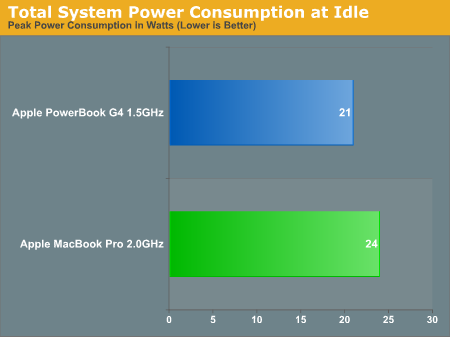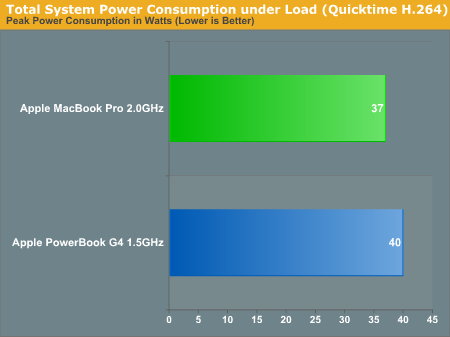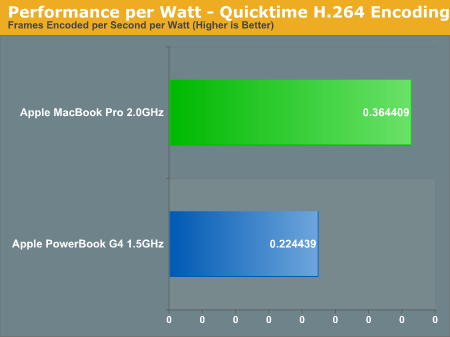Apple's MacBook Pro: Using it as a Mac and a PC
by Anand Lal Shimpi on April 13, 2006 12:00 AM EST- Posted in
- Mac
Power Consumption and Performance per Watt
Compared to the G5, Intel's Core Duo has no problems offering lower power consumption, but what about when pitted against the G4? The whole reason the G4 was kept in Apple's notebook lines was because of its low power consumption; while the Core Duo can easily be a better mobile CPU than the power hungry desktop G5, how does it compare to an already low power G4?
First off, I measured idle power consumption of the entire notebook at the wall outlet. The battery was removed from both notebooks so we're only testing the power consumption of the computer + display.

At idle, the PowerBook G4 running at 1.5GHz manages to come in at 21W total system power consumption, a full 3 Watts lower than the Core Duo 2.0GHz system. The number of variables between the two systems are really too many to count, thus making it difficult to declare this a clear victory for the G4 processor over Core Duo, but it does mean that the older PowerBook G4 notebooks consumes slightly less power as a whole at idle than the newer MacBook Pros.
Next, we ran our QuickTime H.264 encode test and looked at peak power consumption under full CPU load. Keep in mind that QuickTime's H.264 encoder is multi-threaded so both cores are under full load in the MacBook Pro:

Under full load the PowerBook G4 jumps up to 40W while the MacBook Pro falls 3W short and peaks at 37W, giving us a role reversal. It looks like although the older G4 systems consume less power at idle, the MacBook Pro is greener under full load. Of course low power consumption itself is meaningless if you don't have the performance to back it up (remember Transmeta?). Now let's look at the performance per Watt in the previous test.
What I did for this graph was take the average frame rate during the H.264 encode task and divided it by the peak power consumption during the test thus giving us performance measured in frames encoded per second, per Watt.

Using QuickTime's H.264 encoder as our benchmark, the new MacBook Pro offers around 62% better performance per Watt than the previous PowerMac G4. For a notebook, that sort of increase in performance per watt is extremely important.
Interestingly enough, despite the relatively similar power consumption characteristics the new MacBook Pro uses a noticeably larger AC adapter than the PowerMac G4 rated at 85W instead of 65W.










52 Comments
View All Comments
mzlin - Saturday, April 15, 2006 - link
Excellent review, Anand! The Parallels vs Boot Camp comparisons are really well done and very helpful.I thought the comment about PowerBook weight being 1/3 more than any other laptop you've used was a little misleading. I'm sure you didn't mean to say the PowerBook was especially heavy, but since you didn't actually mention what it weighs (5.6 pounds), it could be construed as the Powerbook weighs 1/3 more than other 15.4-inch laptops.
I have been looking for 15.4-inch laptops, PC or Mac, that weigh less than 6 pounds with an integrated optical drive. (For me, having the drive integrated is non-negotiable; I wouldn't want to have it in the wrong place when I needed it, so I would be carrying it around regardless, and much better to save the hassle of digging it out and plugging it in when one needs it.) But the Powerbook/MacBook is the only one I have found so far. On the PC side, the VAIO BX and Toshiba Satellite A105 manage to get to 6.0 pounds, but are also are 1.5 inches thick.
hechacker1 - Saturday, April 15, 2006 - link
I'd just like to point out that the buzzing due to power state switching (transitioning between C3 and C4 states) also happens in windows and linux. It's purely a hardware issue, and in most cases it just means the manufacturer used low quality components (capacitors).In windows it is not as noticible because it runs with a kernel frequency of 100Hz. In linux it's often run with 1000Hz. Because of the increase in frequency of power state switching the buzzing becomes audible to the ear.
In windows it happens 10 times less than most linux boxes. Hence you don't hear it as much even with low quality components. My own Dell 700m laptop has this issue.
The only solution in linux is to disable the lower power states, or change the kernel timer to 100Hz like windows. The best solution is to use dynamic tick switching so you get exactly the responsiveness you need, only when you need it. With a patched linux kernel my laptop automatically goes to 54Hz when idle, and 1000Hz when under load.
Anyways... the only reason those "fixes" work is probably because they cause the processor to do just enough work to avoid having to go into the lowest power mode.
corequadro - Friday, April 14, 2006 - link
I found it as a perfect help against the annoying whine. Just start and then stopp it, and you will – if you aren't using ichat – have a perfectly silent macbook till the next reboot.Of course, a fix from Apple would be more effective, but I can live with the widget fix.
brich - Friday, April 14, 2006 - link
I really think the MacBooks have legs to grow, especially once the intel transition is completed over the next year and universal support becomes more 'universal.' My 12" PowerBook G4 1.5 has served me very well, even with the limitations of XP Pro running in VPC 7 inside Tiger. I think that some of the PC-only enthusiasts who add a MacBook to their arsenal will discover that the integration of excellent hardware esthetic and design with an OS that is continually developing/improving (OSX) will make the Mac solution quite compelling.That said, if I were a user who was totally satisfied with Windows and was not interested in OSX, then I would not buy a Mac to run Windows...no reason to do it. The real differentiation is the new flexibility of the intel Macs with OSX as a viable alternative to XP now and Vista later. Ther ability to run XP on them is frosting on the cake, imho.
ohnnyj - Friday, April 14, 2006 - link
Dear Apple,I want a 12in Merom MacBook.
Desslok - Thursday, April 13, 2006 - link
Acorrding to Daily Tech the hardware bugs you talked about are fixed with the new revs of the MacBook Pro. The article also stated that Apple would allow you to trade your MacBook in if you were having these problems.JAS - Thursday, April 13, 2006 - link
Tonight, I visited an Apple Store to see the MacBook Pro in person. What a gorgeous, well engineered laptop -- and impressively fast! The units on display did have rather warm undersides; but perhaps these are from the initial manufacturing run ("version A").trooper11 - Thursday, April 13, 2006 - link
Great job on the review, it was interesting to see how close things are coming on the software side to run a Windows environment on Macs and pointing out how similar Macs have gotten to every other laptop maker, at least in terms of parts and performance.The thing that gets me now is that the change over to Intel processors and ,in general, a more universal system, has made the Mac just another notebook vendor. So whst the Mac Book Pro has going for it is OS X and any of the Apple software, the machine itself is no better or worse then the many laptop manufacturers putting out Windows based pcs. In the past Macs had sort of mystique relating toa percieved uniqueness.
If everyone realizes this, then Id like to see a review of a Mac Book from the perspective of any normal system evaluation. Comparing the experience with Apple with those of HP, Dell, Acer, or even Lenovo. If Im not a fan of the Mac OS, then I dont see any other reason to pick them over say Acer or Lenovo. I certainly wouldnt pay a price premium for the Apple name unless I saw some first hand reviews relating to price/performance and quality of service you can expect.
anthlover - Thursday, April 13, 2006 - link
Those who have a powerbook that runds under 1ghz will be well served by the new books NOW. Those that have 1.5 and 1.67 have not need to quickly switch unless there is some native apps including apps free ones they want to use.Those that have no book will do well with them.
Waiting unless somthing new was coming out in a couple of weeks is silly. Computers and their prices change constantly, models are refreshed and replaced rapidly. One should always buy what they need and try to future proof too much.
Of course those wanting to save might want to wait for the Ibooks err Mac Book.
Glad to hear replacing the drive got **easier then on the earlier Alumibooks... Or at least the 12 inch one. I got through the keyboard replacement part of the disasemly I had done before and then read ahead to the upper case disassembly and realized that I need a brighter room, no cats trying to help, and a lot of care. Too much risk. With the books It sounds like when you want that 200gb 7200 rpm drive it will be easy to put in:)
plinden - Thursday, April 13, 2006 - link
The choppiness can be made almost unnoticeable by reducing the "Hardware acceleration" - Display Properties/Settings/Advanced/Troubleshooting, and move the slider one notch to the left.